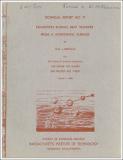Transition boiling heat transfer from a horizontal surface
Author(s)
Berenson Paul Jerome
DownloadHTL_TR_1960_017.pdf (24.83Mb)
Other Contributors
Massachusetts Institute of Technology. Division of Industrial Cooperation. DSR Project no. 7-8077.
Massachusetts Institute of Technology. Heat Transfer Laboratory.
Metadata
Show full item recordAbstract
An experiment, utilising a condensing fluid as the heat source, was performed to determine the heat flux vs. temperature difference curve for transition pool boiling from a horisontal surface. The boiling cure was determined as a function of surface roughness, material, and cleanliness for n-pentane at atmospheric pressure. The results of the experiment show that the liquid contacts the solid heating surface in transition boiling. The burnout heat flux and the film boiling curve are independent of surface properties. For commercial heating surfaces, and probably provided that the combination of surface energies which exist do not result in spreading of the liquid on the solid heating surface, the location of the minimum point is independent of surface properties. It is concluded that transition boiling is a combination of unstable nucleate and unstable film boiling alternating at a given location on the heating surface. The heat transfer data in the transition region was found to be correlated by a straight line on log-log graph paper which connects the burnout point and the minimum point. The bubble spacing and growth rates in film pool boiling from a horizontal surface are shown to be determined by Taylor Hydrodynamic Instability for temperature differences near the minimum. An analytical expression for the heat transfer coefficient in film pool boiling from a horizontal surface is derived. Comb--aing this equation with the equation for the minimum heat flux yields an analytical expression for the temperature difference at the minimum, which defines the location of the minimum point. The above equations agree with the experimental measurements made on n-pentane and carbon tetrachloride within +/- 10%.
Date issued
1960Publisher
Cambridge, Mass. : Massachusetts Institute of Technology, Division of Industrial Cooperation, [1960]
Other identifiers
15186945
Series/Report no.
Technical report (Massachusetts Institute of Technology, Heat Transfer Laboratory) ; no. 17.
Keywords
Boiling-points., Heat -- Transmission.